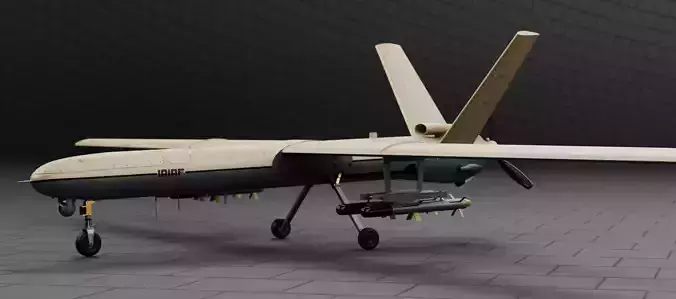1/41
Perfect for use in games and simulation projects.
The HESA Shahed 129 is an Iranian medium-altitude, long-endurance unmanned combat aerial vehicle designed and produced to provide Iran with a domestically manufactured platform for surveillance, reconnaissance, and precision strike missions. Developed by Shahed Aviation Industries and manufactured by the Iran Aircraft Manufacturing Industrial Company (HESA) for the Islamic Revolutionary Guard Corps Aerospace Force, the Shahed 129 conducted its first flight in early 2012 and entered operational service in 2013. Since then, it has been a central element of Iran’s UAV fleet, with more than 40 units believed to have been built and deployed. The airframe of the Shahed 129 is characterized by its slender fuselage, high-aspect-ratio straight wings, and V-tail configuration, bearing a close resemblance in overall layout to the American MQ-1 Predator. The UAV measures approximately 8 meters in length and has a wingspan of about 16 meters. The fuselage diameter is estimated between 0.65 and 0.75 meters. It is powered by a single Rotax 914 four-cylinder, air-cooled piston engine, producing around 75 kilowatts (100 horsepower) of output, driving a pusher-configured three-blade propeller. The configuration provides sufficient power for sustained long-endurance flight at medium altitudes.
The Shahed 129 is designed for mission endurance of up to 24 hours, depending on payload and fuel configuration. Its operational ceiling is around 7,300 meters (24,000 feet). The aircraft has an estimated combat range of approximately 1,700 kilometers, allowing it to conduct strike operations far beyond Iran’s borders. Its maximum ferry range, without weapons and optimized for transit, is believed to reach up to 3,400 kilometers. The UAV can carry a payload of about 400 kilograms, typically consisting of guided munitions and surveillance equipment. It is configured to carry up to four Sadid-345 precision-guided missiles on two underwing twin pylons or up to eight small guided bombs. Sensor equipment includes a stabilized electro-optical/infrared turret for day and night imaging, a laser rangefinder, and potentially synthetic aperture radar or other advanced sensors in upgraded models. The Shahed 129's control system relies on a line-of-sight datalink with an effective range of around 200 kilometers. However, later variants equipped with a prominent nose radome are believed to support satellite communication links, enabling beyond-line-of-sight operations. This enhancement significantly expands its mission flexibility and reach.
The Shahed 129 has been actively deployed in combat operations, including in Syria and Iraq, where it has been used for both reconnaissance and strike missions against opposition forces. It is also used in border surveillance and internal security roles. A maritime variant of the Shahed 129, referred to as Simorgh, has been developed for naval operations. In recent years, reports have suggested that the Shahed 129 or its derivatives have been transferred to Russia for operational use in conflicts such as the war in Ukraine, where they supplement existing drone capabilities. The Shahed 129 represents a key achievement in Iran’s efforts to develop independent unmanned combat aerial vehicle technology. It combines extended endurance, a meaningful strike capability, and domestic production, allowing Iran to conduct regional operations without reliance on foreign UAV suppliers. The platform continues to be upgraded and adapted as Iran advances its UAV and autonomous systems technologies.
Formats include: OBJ, FBX. Feel free to check out the other models, just click on the user name to see the complete portfolio.
REVIEWS & COMMENTS
accuracy, and usability.









































